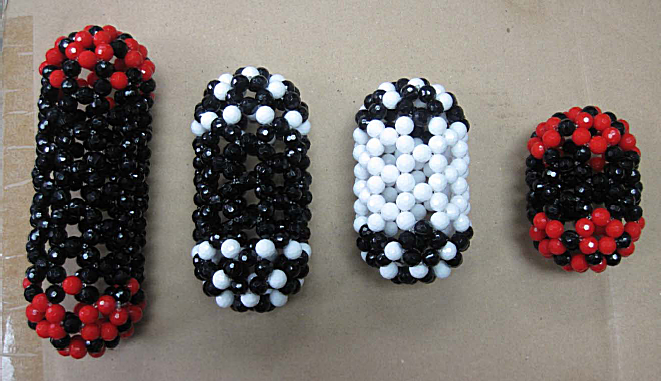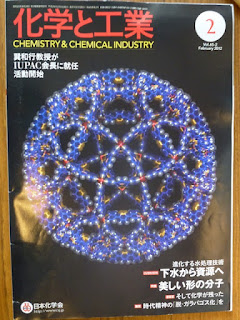I made two more high-genus fullerenes with octagonal necks using 8mm beads and 0.6mm Nylon threads. If I remember everything correctly, Chern and I should have made four of this molecule (one in China and three in U.S.) before.
HG-Fullerenes with octagonal necks No. 5 & No. 6
Since this model contains less than one thousand beads, so I managed to finish one of them in a day.
Monday, March 26, 2012
Tuesday, March 20, 2012
形狀美麗的分子(Chemistry & Chemical Industry, Vol. 62, 2012)
Prof. Sonoda (園田高明) of Kyushu University sent me a special issue on "Beautifully Shaped Molecules" of "Chemistry & Chemical Industry" published by Japanese Chemical Society. There are five articles by famous Japanese chemists in this issue. The photos I showed here are from an article on "Self-Assembled Polyhedra" (my translation based on the Kanji in the title, I don't know Japanese, though) by Makato Fujita (藤田 誠) of Tokyo University.
Monday, March 19, 2012
Photos of Workshop for Exchange Students from Okayama Univeristy
Mr. Hwang took many photos for my workshop last Tuesday.
As usual, I gave a 30-min short talk before we started to make beaded C20 and C60.
While I was talking, students were free to examine the beadworks I brought to the workshop.
Prof. Sonoda (Kyushu University) also visited Taiwan in those few days. So I invited him to this workshop. He seemed to have fun making a beaded C20.
Almost all of students succeeded in making their own C20 and C60 in this 3-hour workshop. You can see how happy they were when they finally made their own buckyballs. After the workshop, I took a picture with my colleagues.
As usual, I gave a 30-min short talk before we started to make beaded C20 and C60.
While I was talking, students were free to examine the beadworks I brought to the workshop.
Prof. Sonoda (Kyushu University) also visited Taiwan in those few days. So I invited him to this workshop. He seemed to have fun making a beaded C20.
Almost all of students succeeded in making their own C20 and C60 in this 3-hour workshop. You can see how happy they were when they finally made their own buckyballs. After the workshop, I took a picture with my colleagues.
Another unfinished (1,1) P-surface
I found an unfinished (1,1) P-surface made by Chern before. I should have used it as the starting point last week.
Sunday, March 18, 2012
P-surface with the Goldberg vector (1,1)
In principle, it is possible to construct a graphitic P-surface with neighbored octagons separated by any Goldberg vector, (h, k). Most of the beaded P-surfaces I posted before have the vector (2,0). The smallest graphitic P-surface has a vector of (h,k)=(1,0) and its bead model was built by Chern long time ago.
Here is the bead model of P-surface with (1,1) I made this weekend. Unlike (2,0)-surface, the bead model of (1,1)-surface is a little bit crowded though.
Single unit cell:
2x2x2:
Here is the bead model of P-surface with (1,1) I made this weekend. Unlike (2,0)-surface, the bead model of (1,1)-surface is a little bit crowded though.
Single unit cell:
2x2x2:
Wednesday, March 14, 2012
photos from TFGH
Fan-Fei (周芳妃老師), chemistry teacher of the Taipei First-Girls' High School (TFGH), informed me a site with many pictures she and her colleagues took for several events from Nov. 9 to Dec. 11, 2011.
1. Nov. 9, 2011: students and teachers of TFGH attent my exhibition "The Fabulous World of Beaded Molecules" held in our department.
2. Nov. 28, 2011: Students of TFGH visited our department and I gave a talk "珠璣科學" for them.
3. Nov. 2-11, 2011: We collaborated on the superbuckyball.
1. Nov. 9, 2011: students and teachers of TFGH attent my exhibition "The Fabulous World of Beaded Molecules" held in our department.
2. Nov. 28, 2011: Students of TFGH visited our department and I gave a talk "珠璣科學" for them.
3. Nov. 2-11, 2011: We collaborated on the superbuckyball.
Monday, March 12, 2012
Eight structural types of TCNTs with latitude coordinates
Here are all eight structural types of TCNTs in the show case located in the third floor of chemistry building(NTU). Four of them belong to Dnh point group and the other four belong to Dnd group. Chern made the three in blue and white long time ago and I made the other five in red in order to have the whole set with 6mm faceted beads after I read the paper in Chem. Eur. J.
Tuesday, March 6, 2012
Dodecahedral Carbon Schwarzite
Previously, I discussed how to construct a locally hyperbolic tetrahedral building block by puncturing four holes on a tetrahedral C84 along its four tetrahedral axes. This basic unit consists of 12 heptagons, which make the local curvature negative. We can create many different kinds of interesting structures by using this kind of building blocks. One possibility is a dodecahedron. The angle between two axes emanating from the center to two any two vertices (the "tetrahedral angle") of a tetrahedron is 109.47°, which is slightly larger than the inner angle of a dodecahedron (108°). This means that we can use them to construct a dodecahedron without introducing too much local strain. Below is a dodecahedral bead model consisting of 20 such units I just made today. It took me about one week to bead all twenty units and connect them together. More than 2500 8mm faceted beads are used to make this model.
German mathematician Herman Schwarz first proposed P- and D-types triply periodic minimal surfaces (TPMS) in the 19th century. Later, about twenty years ago, Lenosky et al. theoretically suggested graphitic structures with suitable arrangement of seven-membered rings decorated in P- and D-TPMS as possible model structures of sponge carbon. Now, chemists and physicists call this kind of graphitic structures with negative Gaussian curvatures as Schwarzites. The one I have here satisfies this criteria, so we might call it the dodecahedral carbon Schwarzite.
German mathematician Herman Schwarz first proposed P- and D-types triply periodic minimal surfaces (TPMS) in the 19th century. Later, about twenty years ago, Lenosky et al. theoretically suggested graphitic structures with suitable arrangement of seven-membered rings decorated in P- and D-TPMS as possible model structures of sponge carbon. Now, chemists and physicists call this kind of graphitic structures with negative Gaussian curvatures as Schwarzites. The one I have here satisfies this criteria, so we might call it the dodecahedral carbon Schwarzite.
Monday, March 5, 2012
Pillar-shaped C60 and related C72
There are 1812 isomers of C60. Only the one with the shape of a soccer ball is stable enough and can be synthesized routinely. However, chemists in the Xiamen university have successfully created a few chlorinated isomers of C60 three years ago. I will try to make bead models of them when I find time. Here I would like to show the bead model of another elusive isomer of C60 with pillar shape (point group, D6h) which might be found someday.
Of course, there is a whole series of pillar-shape fullerenes by simply inserting short rings of carbon nanotubes. Here is the bead model of C72, which is the second one in this series.
Building blocks for pseudo D-type Schwarzite
I just noticed that I already have a picture of punctured C84 in the logo of this blog the other day. I checked my photo library and found another picture of this model which was taken almost five years ago. I possibly made this bead model after reading the paper on Nature with title "Energetics of negatively curved graphitic carbon" by Lenosky et al. (1992 vol. 355, 333-335).
However, we now know this is not a true triply periodic minimal surface. The correct D surface should partition the space into two congruent parts. It is not possible to get such a structure if one use heptagons.
Of course, we now know how to make a correct D-type Schwarzite which exactly partition the space into two identical regions. Wei-Chi made this beautiful bead model of D-type Schwarzite a few years ago.
However, we now know this is not a true triply periodic minimal surface. The correct D surface should partition the space into two congruent parts. It is not possible to get such a structure if one use heptagons.
Of course, we now know how to make a correct D-type Schwarzite which exactly partition the space into two identical regions. Wei-Chi made this beautiful bead model of D-type Schwarzite a few years ago.
Thursday, March 1, 2012
Making Beaded Buckyball Model in Chinese
If you can read Chinese, you might want to look at the following detailed tutorials by a teacher, 薛朋雨, at the Taichung First High School (國立台中第一高級中學):
化學教室活動:製作巴克球的串珠模型(Making Beaded Buckyball Model)〔I〕
化學教室活動:製作巴克球的串珠模型(Making Beaded Buckyball Model)〔II〕
化學教室活動:製作巴克球的串珠模型(Making Beaded Buckyball Model)〔III〕

化學教室活動:製作巴克球的串珠模型(Making Beaded Buckyball Model)〔I〕
化學教室活動:製作巴克球的串珠模型(Making Beaded Buckyball Model)〔II〕
化學教室活動:製作巴克球的串珠模型(Making Beaded Buckyball Model)〔III〕

Subscribe to:
Posts (Atom)

























